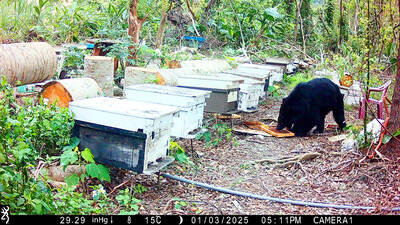Taiwanese researchers have discovered that copper oxide can be used in the production of hydrogen fuel in a finding that could revolutionize the efficiency and cost-effectiveness of hydrogen technology.
The study, published in Nature Communications on Feb. 1, was conducted by Lin Yan-gu (林彥谷) of the National Synchrotron Radiation Research Center in collaboration with researchers from National Yang Ming Chiao Tung University in Taiwan and the Max Planck Institutes in Germany.
Hydrogen energy is one of the technologies being explored as a replacement for fossil fuels as part of the global effort to achieve net zero carbon emissions by 2050 while meeting the world’s energy needs, the center said in a statement yesterday.

Photo courtesy of the National Synchrotron Radiation Research Center
Currently, hydrogen fuel is produced either by extraction from fossil fuels, which is known as “gray hydrogen,” as it still releases carbon into the environment, or by splitting water via electrolysis, which is called “green hydrogen,” as the process is carbon-free.
However, water-splitting technology has not become mainstream, as it requires the use of high-voltage electricity and expensive catalysts, such as platinum and iridium, the center said.
The researchers proved that copper oxide can be utilized as a cheap and effective alternative to current catalysts by injecting hydrogen atoms into a copper oxide catalyst, it said.
The cuprous oxide catalyst enables continuous water splitting for more than 100 hours using low-voltage electricity, which significantly reduces energy consumption, the center said.
The material’s lifetime is 10 times longer than catalysts in use and 10,000 times cheaper than commercial iridium, it said.
The team determined that the greater efficiency of copper oxide stems from a compound within the substance called trivalent copper, which is highly unstable and virtually non-existent in nature, it said.
The researchers used the facilities at the Taiwan Photon Source, the Taiwan Light Source and Taiwanese Beamlines at the SPring-8 synchrotron radiation facility in Japan for the study, the center said.
The project is part of the center’s efforts to develop green technologies to facilitate Taiwan’s bid to become a net zero economy by 2050, it said.

SHIPS, TRAINS AND AUTOMOBILES: The ministry has announced changes to varied transportation industries taking effect soon, with a number of effects for passengers Beginning next month, the post office is canceling signature upon delivery and written inquiry services for international registered small packets in accordance with the new policy of the Universal Postal Union, the Ministry of Transportation and Communications said yesterday. The new policy does not apply to packets that are to be delivered to China, the ministry said. Senders of international registered small packets would receive a NT$10 rebate on postage if the packets are sent from Jan. 1 to March 31, it added. The ministry said that three other policies are also scheduled to take effect next month. International cruise ship operators

NUMBERS IMBALANCE: More than 4 million Taiwanese have visited China this year, while only about half a million Chinese have visited here Beijing has yet to respond to Taiwan’s requests for negotiation over matters related to the recovery of cross-strait tourism, the Tourism Administration said yesterday. Taiwan’s tourism authority issued the statement after Chinese-language daily the China Times reported yesterday that the government’s policy of banning group tours to China does not stop Taiwanese from visiting the country. As of October, more than 4.2 million had traveled to China this year, exceeding last year. Beijing estimated the number of Taiwanese tourists in China could reach 4.5 million this year. By contrast, only 500,000 Chinese tourists are expected in Taiwan, the report said. The report

The Forestry and Nature Conservation Agency yesterday launched a gift box to market honey “certified by a Formosan black bear” in appreciation of a beekeeper’s amicable interaction with a honey-thieving bear. Beekeeper Chih Ming-chen (池明鎮) in January inspected his bee farm in Hualien County’s Jhuosi Township (卓溪) and found that more than 20 beehives had been destroyed and many hives were eaten, with bear droppings and paw prints near the destroyed hives, the agency said. Chih returned to the farm to move the remaining beehives away that evening when he encountered a Formosan black bear only 20m away, the agency said. The bear

HORROR STORIES: One victim recounted not realizing they had been stabbed and seeing people bleeding, while another recalled breaking down in tears after fleeing A man on Friday died after he tried to fight the knife-wielding suspect who went on a stabbing spree near two of Taipei’s busiest metro stations, Taipei Mayor Chiang Wan-an (蔣萬安) said. The 57-year-old man, identified by his family name, Yu (余), encountered the suspect at Exit M7 of Taipei Main Station and immediately tried to stop him, but was fatally wounded and later died, Chiang said, calling the incident “heartbreaking.” Yu’s family would receive at least NT$5 million (US$158,584) in compensation through the Taipei Rapid Transit Corp’s (TRTC) insurance coverage, he said after convening an emergency security response meeting yesterday morning. National